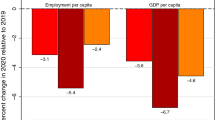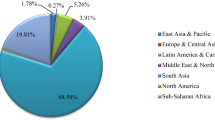Abstract—
The article examines the incidence of COVID-19 in Russia within a framework of the endogenous growth model. All regions of Russia were divided into three groups according to the incidence rate values, for each of which threshold regression models were constructed for 2008–2018, where the threshold is the stock of human capital. For group 1, two thresholds were identified, and a negative statistically significant relationship was found between public health expenditure and GRP per capita. This indicates the inefficiency of investments in terms of their opportunity cost. The regional health systems of group 1 require federal assistance. For groups 2 and 3, the dependence is also negative, but insignificant, indicating the need to modernize their healthcare systems, at least in developing the infectious service.



Similar content being viewed by others
Notes
Porfiriev, B.N., Coronacrisis: In search of a “vaccine” for the economy, Nauchnaya Rossiya, December 8, 2021.
Johns Hopkins COVID-19 Resource Center. https://coronavirus.jhu.edu/map.html. Accessed July 22, 2022.
Johns Hopkins COVID-19 Resource Center. https://coronavirus.jhu.edu/map.html. Accessed July 22, 2022.
Kheneneva, V., Since July 2, restrictions imposed due to the coronavirus pandemic have been lifted in Russia, Gazeta.ru, July 1, 2022. https://www.gazeta.ru/social/news/2022/07/ 01/18046442.shtml. Accessed July 19, 2022.
Regions are distributed by incidence data. There was an outlier at the maximum; therefore, three regions were placed in a separate group. The rest of the data increased relatively evenly, so the dataset was divided into two groups.
Group 1: Astrakhan, Belgorod, Ivanovo, Kaluga, Kostroma, Kursk, Oryol, Ryazan, Smolensk, and Tambov oblasts; the Republic of Karelia; Murmansk, Novgorod, and Pskov oblasts; the republics of Adygea, Kalmykia, Dagestan, Ingushetia, Kabardino-Balkaria, Karachay-Cherkessia, North Ossetia–Alania, Chechnya, Mari El, Mordovia, and Chuvashia; Kurgan oblast; the republics of Altai, Buryatia, Tyva, Khakassia; Tomsk oblast; Kamchatka krai; Amur, Magadan, and Sakhalin oblasts; the Jewish Autonomous Oblast; Chukotka Autonomous Okrug. Group 2: Bryansk, Vladimir, Voronezh, Lipetsk, Tver, Tula, and Yaroslavl oblasts; the Komi Republic; Arkhangelsk, Vologda, Kaliningrad, and Leningrad oblasts; Krasnodar krai; Volgograd and Rostov oblasts; Stavropol krai; the republics of Bashkortostan, Tatarstan, and Udmurtia; Perm krai; Kirov, Nizhny Novgorod, Orenburg, Penza, Samara, Saratov, Ulyanovsk, Sverdlovsk, Tyumen, and Chelyabinsk oblasts; Altai, Zabaykalsky, and Krasnoyarsk krais; Irkutsk, Kemerovo, Novosibirsk, and Omsk oblasts; Republic of Sakha; Primorsky and Khabarovsk krais. Group 3: Moscow, St. Petersburg, Moscow oblast.
Hurlin C., Panel Threshold Regression Models, 2018. Chapter 3. https://www.univ-orleans.fr/deg/mas-ters/ESA/CH/ Geneve_Chapitre3.pdf. Accessed July 25, 2022.
The author calculated models with one and two thresholds and chose the most adequate specification.
Sergeev, A., The Ministry of Health reported a decrease in life expectancy by 3.3 years due to the pandemic, Rossiiskaya Gazeta, October 19, 2022.
Sokolov, A., Money does not heal: What does healthcare reform lead to?, Vedomosti, October 15, 2020.
REFERENCES
Durlauf, S.N., Johnson, P.A., and Temple J.R.W., The methods of growth econometrics, in Palgrave Handbook of Econometrics, Mills, T.C. and Patterson, K., Eds., Houndmills: Palgrave Macmillan, 2000, vol. 2, pp. 1119–1179.
Ekonomika i ekonomicheskaya politika v usloviyakh pandemii (Economics and Economic Policy in a Pandemic), Kudrin, A.L., Ed., Moscow: Inst. Gaidara, 2021.
Enikolopov, R., Introduction, in Ekonomicheskaya politika vo vremya COVID-19 (Economic Policy During COVID-19), Moscow: Ross. Ekon. Shk., April 2020, pp. 3–10.
Fernandes, N., Economic effects of the coronavirus outbreak, SSRN Working Paper, April 13, 2020. Fu, Q. and Chang, C.-P., How do pandemics affect government expenditure, Asian Econ. Lett., vol. 2, no. 1, pp. 1–5.
Itskhoki, O., New coronavirus and economics, in Ekonomicheskaya politika vo vremya COVID-19 (Economic Policy During COVID-19), Moscow: Ross. Ekon. Shk., April 2020, pp. 11–15.
Kaneva, M. and Untura, G., The impact of R&D and knowledge spillovers on the economic growth of Russian regions, Growth Change, 2019, vol. 50, pp. 301–334.
Kaneva, M.A. and Untura, G.A., Dependence of regional growth rates on healthcare expenditures: evaluation by threshold regression, Reg. Ekon.: Teor. Prakt., 2022, vol. 20, no 2, pp. 355–381.
Kolomak, E., Economic effects of pandemic-related restrictions in Russia and their spatial heterogeneity, R-Econ., 2020, vol. 6, no. 3, pp. 154–161.
Li, Q., Chen, F., and Hu, S., Spatial spillover effect of government public health spending on regional economic growth during the COVID-19 pandemic, Complexity, 2021, vol. 2021, p. 5552552. https://doi.org/10.1155/2021/5552552
Lokshin, M. and Ravallion, M., Testing for an economic gradient in health status using subjective data, Health Econ., 2008, vol. 17, no. 11, pp. 1237–1259.
Nicola, M., et al., The socio-economic implications of the coronavirus pandemic (COVID-19): A review, Int. J. Surg., 2020, vol. 78, pp. 185–193.
Niu, X.T., Yang, Y.C., and Wang, Y.C., Does the economic growth improve public health? A cross-regional heterogeneous study in China, Front. Publ. Health, 2021, vol. 9. https://doi.org/10.3389/fpubh.2021.704155
Obshchestvo i pandemiya. Opyt i uroki bor’by s COVID-19 v Rossii (Society and the Pandemic. Experience and Lessons of the Fight Against COVID-19 in Russia), Mau, V.A., Ed., Moscow: Delo, 2020.
Polozhikhina, M.A., Russian economy in the context of the coronavirus pandemic, Ekon. Probl. Ross., 2021, no. 4, pp. 39–63.
Proizvoditel’nost’ truda i rossiiskii chelovecheskii kapital: paradoksy vzaimosvyazi (Labor Productivity and Russian Human Capital: Paradoxes of Interconnection), Gimpel’son, V.E., Avdeeva, D.A., Akindinova, N.V., et al., Moscow: Vyssh. Shk. Ekon., 2021.
Rossiiskaya ekonomika v 2021 g.: tendentsii i perspektivy (Russian Economy in 2021: Trends and Prospects), Kudrin, A.L., Ed., Moscow: Inst. Gaidara, 2021.
Seliverstov, V.E., Kravchenko, N.A., Klistorin, V.I., and Yusupova, A.T., Russian regions and the Federal Center against global threats: A year of fighting COVID-19, Reg. Res. Russ., 2021a, vol. 11, no. 4, pp. 405–418.
Seliverstov, V., Leksin, I., Kravchenko, N., Klistorin, V., and Yusupova, A., Russia’s fight against COVID-19. Dealing with a global threat under crisis and stagnation, in Comparative Federalism and COVID-19: Combating the Pandemic, Steytler, N., Ed., Routledge, 2021b, Ch. 9, pp. 160–178.
Wang, Q., Fixed-effect panel threshold model using stata, Stata J., 2015, vol. 15, no. 1, pp. 121–134.
Zemtsov, S.P., and Baburin, V.L., COVID-19: Spatial dynamics and spread factors across Russian regions, Reg. Res. Russ., 2020, vol. 10, no. 3, pp. 273–290.
Funding
The study was conducted within the Research Plan of the Institute of Economics and Industrial Engineering, Siberian Branch, Russian Academy of Sciences, “Regional and Municipal Strategic Planning and Management in the Context of Modernizing State Regional Policy and Developing the Digital Economy,” project no. 121040100283-2.
Author information
Authors and Affiliations
Corresponding author
Ethics declarations
The author declares that she has no conflicts of interest.
Rights and permissions
About this article
Cite this article
Kaneva, M.A. Determinants of Economic Growth in Regions with Different COVID-19 Incidence Rates. Reg. Res. Russ. 13, 296–304 (2023). https://doi.org/10.1134/S2079970523700612
Received:
Revised:
Accepted:
Published:
Issue Date:
DOI: https://doi.org/10.1134/S2079970523700612




